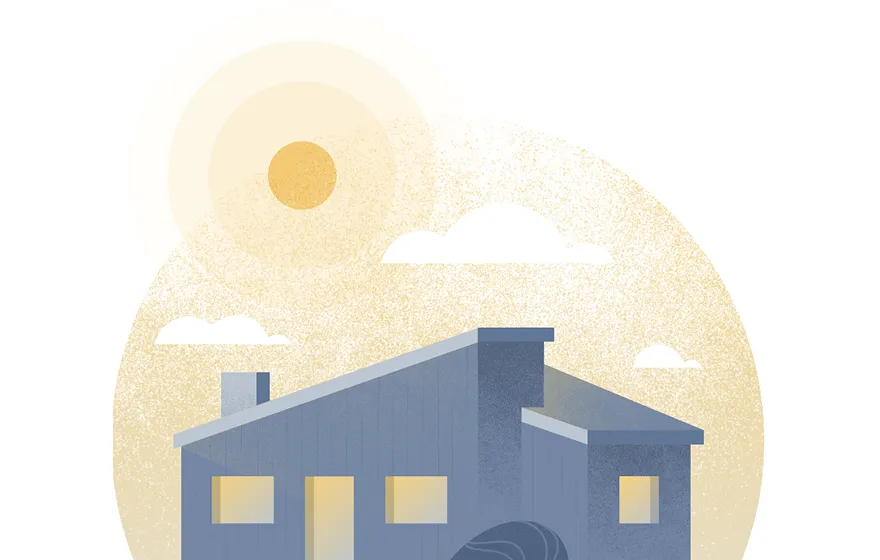Nothing lasts forever, and that includes your mortgage, too. Sometimes, though, you need to make a change sooner than you thought. Perhaps rates have dropped significantly since you purchased your home, or you've discovered it requires more renovations than you initially anticipated.
In any case, how soon you can refinance a mortgage depends on a few factors, like what type of loan program you’re using and how much you’re borrowing. Generally speaking, you’ll need to wait between 30 days and 12 months before you’re able to refinance your mortgage. Let’s take a closer look at how it works.
How soon after buying a house can you refinance?
Most mortgage lenders require that you keep your original mortgage for a certain period of time before you’re eligible to refinance again. These are known as “seasoning requirements,” and they can vary anywhere from 30 days to 12 months, depending on the type of refinance you’re going for, the loan amount, and more.
Aside from the seasoning requirements, there may be other limits in place that impact when you’re eligible to refinance your home. Case in point: mortgage lenders will consider many of the same factors as when you took out your first loan, like credit scores, debt-to-income (DTI) ratios, loan-to-value (LTV) ratio, etc. If you put down less than 20 percent on your original mortgage, for example, it may still be several years before refinancing your mortgage is possible.
We’ll break it down for each type of mortgage program.

Conventional mortgage loan refinance
Most mortgage refinances are done using a conventional loan. The two government-sponsored enterprises, Fannie Mae and Freddie Mac, generally set the base terms for refinancing your loan, although individual lenders who serve as your direct liaison often have their own requirements, too.
Here are the specific refinancing requirements for most conventional mortgages, depending on the type of loan you’re using:
- Conventional rate-and-term refinance: You can refinance in 30 days, with a maximum LTV ratio of 95%.
- Conventional cash-out refinance: You can refinance in 12 months, as long as at least one of the borrowers has been listed on the home’s title for six months or more (except for certain cases, like if you inherited the house). The maximum LTV ratio is 80%.
FHA loan refinance
The FHA loan program is a popular option for people who don’t have enough savings or credit to qualify for a traditional mortgage loan. They come with additional costs, which is why many people seek to refinance out of an FHA loan and into a more affordable alternative, such as a conventional loan, once they’re able to qualify.
That said, you can choose to refinance into an FHA loan, too. There are several flavors of FHA loans, but — broadly speaking — you’ll need to have made at least six monthly payments on your current loan before you’re eligible to refinance into a new FHA loan. This means you might need to wait at least 210 days (i.e., seven months) after your loan closes before you’re eligible.
The LTV ratios vary a bit more depending on your situation and the type of FHA refinance loan you’re applying for. Cash-out refis allow for LTVs up to 80% of your home’s value, for example, while FHA rate-and-term refis allow for LTVs ranging from 85% to 97.75%, depending on whether you’re refinancing a first or a second home, and how long you’ve lived in it for.
VA loan refinance
Mortgages insured by the VA offer a lot of benefits for those who qualify, so it makes sense to continue with the VA program. It offers two main refinance options. The VA Interest Rate Reduction Refinance Loan (IRRRL) offers potential savings by lowering your rates, while some lenders also offer a VA cash-out refinance loan, too.
Both VA refinance loan options come with a 210-day seasoning requirement after you make your first payment. The LTV ratios differ, however. An IRRRL loan has no set LTV requirements, whereas VA cash-out refinance loans specify a maximum LTV ratio of up to 100%.
USDA loan refinance
The USDA only allows for rate-and-term refis and has no provision for cash-out options. You’ll need to wait at least 12 months to refinance a USDA loan, and your six most recent payments must have been made on time (for Streamlined-Assist refinances, your 12 most recent payments must have been made on time).
When it makes sense to refinance
Although it’s often possible to refinance your mortgage in very short order after buying your home, it’s a good idea to thoroughly assess your plan first. After all, refinancing can be a great way to reach your financial goals faster, but it can also have the opposite effect, too.
Here are some specific cases when refinancing a newer mortgage might be a good idea:
- Borrow money: A cash-out refinance can help you pull equity out of your home for additional funds. New homeowners often discover projects and repairs they need to complete, and this can be a cost-effective way to pay for them.
- Change loan servicers: Refinancing with a different lender can help you escape poor customer service. Just make sure your new lender doesn’t contract with the same company to service its loans.
- Get a better interest rate: This is a major reason that drives people to refinance. If rates have dropped or your credit score has increased, you may be able to qualify now for lower rates than when you first bought your home.
- Pay off your home sooner: If you qualify for a lower interest rate, it can help you pay off your mortgage sooner, especially if you choose a shorter term length. This can make your monthly payments higher, however.
- Switch interest rate types: If you currently have an adjustable-rate mortgage (ARM), switching to a fixed-rate loan can help stabilize your payments. Likewise, switching to an ARM may help you get an even lower rate if you’re able to handle fluctuating payments.
- Get a more affordable payment: Refinancing for a longer term length and/or a smaller interest rate can help reduce your monthly payment amount to a level that’s easier to afford.
- Change your mortgage term length: Refinance loans are available in more term length options than a standard mortgage, often ranging from 10 to 30 years. Choosing a longer term length may lower your monthly payments but increase your long-term costs, and vice versa.
- Remove mortgage insurance premiums: Conventional loans typically require private mortgage insurance (PMI) if you put less than 20% down on a home. You can remove it later on, subject to a list of qualifications. If your lender won’t grant your request, refinancing with a new lender might help you remove that extra cost.
- Add or remove a co-borrower on the loan: Newlywed couples commonly refinance a home in both their names. It’s equally common to refinance a mortgage in one person’s name during divorce proceedings, too.
Alternatives to mortgage refinance
We’ve seen that there are many reasons why people choose to refinance a mortgage, even if it hasn’t been very long since they bought their home. Yet, refinancing your new home isn’t always the best option. Here are some other alternatives to consider first:
- Personal loan: These smaller loans don’t use your home equity and are faster to get. You can use them for anything you’d use a cash-out refinance loan for, too.
- Home equity loans and HELOCs: These are second mortgages that allow you to borrow funds without switching up your primary mortgage.
- Home equity investments: HEIs also offer a pathway to borrowing against your home equity without touching your primary mortgage. An HEI requires no monthly payments, and is instead repaid up to 30 years later as a share of your home’s growth in equity.
- Loan modification programs: Lenders generally offer options for managing your monthly payment without refinancing. Some are permanent, like lengthening your loan term, while others, like forbearance, are temporary solutions for short-term financial hurdles.
Frequently asked questions
When can I refinance my house?
You can refinance your house in as little as a month with a conventional loan if you meet the requirements. Other loan programs may require you to wait as long as 12 months or more before you’re eligible.
What to consider before refinancing?
It’s important to have a good grasp of the loan costs before you refinance, both in terms of your monthly mortgage payments and the lifetime cost of the loan. Extending your loan term may save you money in the short run, for example, but could cost you a lot more in the long run. In addition, it’s important to consider alternatives to refinancing, like home equity loans, HELOCs, or home equity investments.
How much does it cost to refinance?
The closing costs when you refinance are basically the same as when you took out your mortgage in the first place, typically ranging from 2% to 6% of the loan. Even if you refinance with the same lender, the cost is generally the same.
Can I tap into my equity with refinancing?
Yes—there are several ways to access your home’s equity without going through a traditional refinance. Options include home equity loans, HELOCs, home equity investments (HEIs), and even reverse mortgages, depending on your needs and eligibility. Each option has different requirements, so it’s worth comparing what works best for your situation.

The bottom line
Refinancing a mortgage is a major undertaking. That’s especially true if you’re refinancing soon after buying your house. Often, homeowners haven’t had sufficient time to build up enough equity to qualify at all. Even if they do, refinancing has the potential to reduce the equity they’ve worked hard to build since buying the home.
If a mortgage refinance aligns with your goals and qualifications, though, it can be a powerful tool in your financing kit.
No income? No problem. Get a home equity solution that works for more people.
Prequalify in 60 seconds with no need for perfect credit.
Show me my offer
Frequently asked questions

Thank you for subscribing!
.webp)















